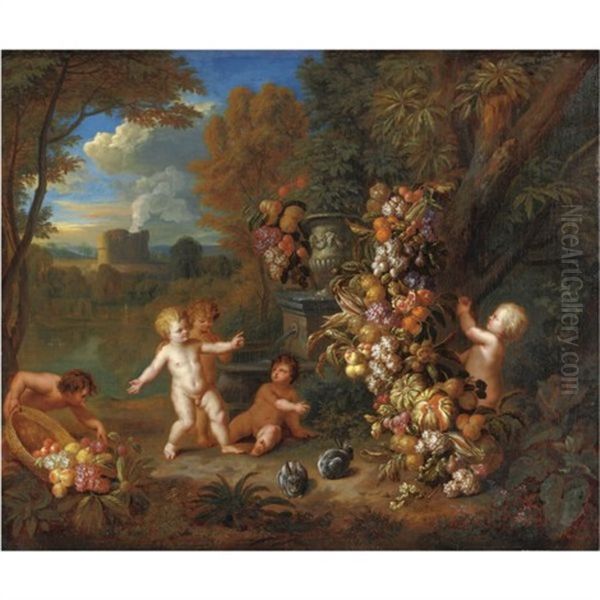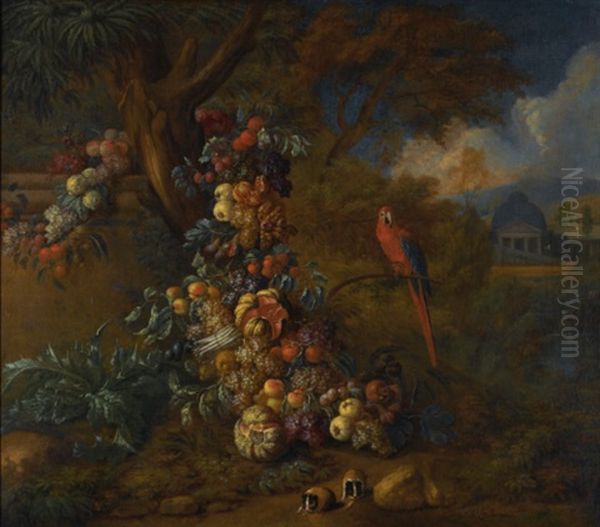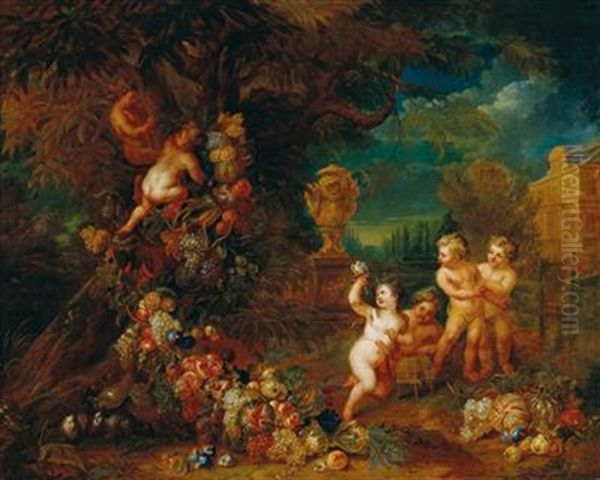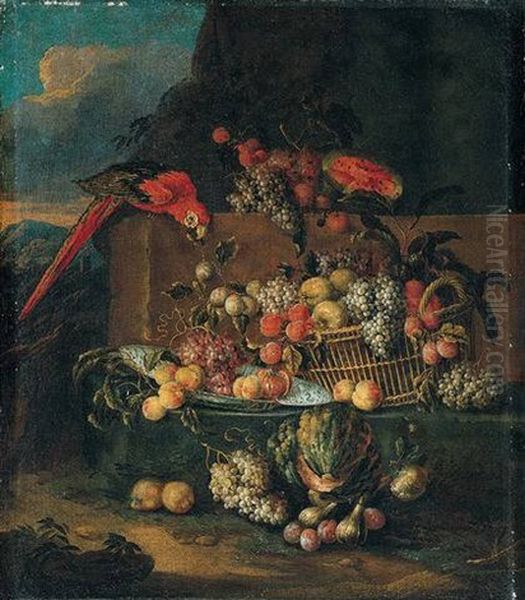Introduction: An Antwerp Legacy
Jan Pauwel Gillemans the Younger stands as a significant figure within the rich tradition of Flemish Baroque painting, particularly celebrated for his contributions to still life. Born in the bustling artistic hub of Antwerp in 1651, he inherited a direct artistic lineage as the son of the equally respected still-life painter, Jan Pauwel Gillemans the Elder. Active during the latter half of the 17th century until his death, likely around 1702, Gillemans the Younger carved out his own niche, specializing in vibrant and meticulously detailed depictions of fruit and flowers, continuing and evolving the Flemish penchant for capturing the beauty of the natural world. His acceptance into the prestigious Antwerp Guild of Saint Luke marked his official entry into the professional art world of his time.
Early Life and Artistic Formation
Growing up in Antwerp, Jan Pauwel Gillemans the Younger was immersed in a city renowned for its artistic output. The influence of his father, Jan Pauwel Gillemans the Elder (c. 1618–1675), was undoubtedly foundational. The elder Gillemans was himself a master in the Guild of Saint Luke and a recognized specialist in still life, particularly fruit arrangements. This familial connection provided the younger Gillemans with an intimate exposure to the techniques and themes prevalent in Flemish still-life painting from an early age. He learned the craft within a household dedicated to art, absorbing the meticulous observation and rendering skills essential for the genre.
Beyond his father's direct influence, the artistic environment of Antwerp offered numerous sources of inspiration and learning. The snippets suggest a strong connection to Joris van Son (1623–1667), another prominent Antwerp still-life painter known especially for his elaborate garland paintings. While some sources suggest Gillemans the Younger may have been a student of Van Son, it is certain that Van Son's style, particularly his decorative arrangements and compositions featuring swags of fruit and flowers, left a discernible mark on Gillemans's work. The emphasis on abundance and decorative richness seen in Van Son's paintings resonates in many of Gillemans the Younger's compositions.

Furthermore, the pervasive influence of the great Jan Davidsz. de Heem (1606–1683/84), who worked in both Utrecht and Antwerp, cannot be overlooked. De Heem was a towering figure in still-life painting, celebrated for his opulent compositions, sophisticated use of light, and ability to render diverse textures. Gillemans the Younger's work, especially perhaps his earlier pieces, shows an awareness of De Heem's achievements in creating complex, richly detailed still lifes that often carried symbolic undertones. The broader Antwerp school, with masters like David Teniers the Younger and Jacob Jordaens active in other genres, created a dynamic atmosphere of artistic excellence that shaped Gillemans's development.
The Guild of Saint Luke and Professional Career
A crucial milestone in Jan Pauwel Gillemans the Younger's career was his acceptance as a master ('wijnmeester', son of a master) into the Antwerp Guild of Saint Luke in the guild year 1673-1674. Membership in the Guild was essential for artists wishing to practice professionally, take on apprentices, and sell their work legally within the city. It signified peer recognition and adherence to the high standards of craftsmanship upheld by the institution. His entry confirmed his status as an independent and accomplished artist, ready to contribute to Antwerp's artistic reputation.
Gillemans the Younger remained active as an artist primarily between 1674 and his death around 1702. While Antwerp was his home base and the center of his professional life, his reputation and activities extended beyond the confines of Flanders. The available information indicates that he was also active, perhaps through travel or the dissemination of his works, in major European centers including London, Paris, and Milan. This suggests that his paintings found an appreciative audience among international patrons and collectors, reflecting the widespread appeal of Flemish still life during this period. His ability to connect with markets in these diverse cultural capitals speaks to the quality and desirability of his art.
Artistic Style and Thematic Focus
Jan Pauwel Gillemans the Younger specialized primarily in still life, focusing predominantly on arrangements of fruit and flowers. His style is firmly rooted in the Flemish Baroque tradition, characterized by naturalism, meticulous attention to detail, and a keen sensitivity to texture and light. He excelled at rendering the varied surfaces of fruits – the velvety skin of peaches, the translucent glow of grapes, the rough peel of citrus – often juxtaposing them with delicate flower petals and foliage. His works frequently feature an abundance of elements, creating compositions that are both visually rich and decoratively appealing.

His technique involved careful observation and precise execution. He often worked on durable supports like oak panels or copper plates, which allowed for a high degree of finish and detail. The smooth surface of copper, in particular, could enhance the luminosity and jewel-like quality of the paint. Gillemans skillfully manipulated light and shadow (chiaroscuro) to model forms, create depth, and highlight the textures and vibrant colours of his subjects. This careful handling of light contributes significantly to the realism and tactile quality of his paintings.
A recurring motif in his work is the fruit or flower garland, often depicted hanging decoratively or encircling a central element like a cartouche, niche, or, as seen in some examples, a fountain. This compositional device was popularized in Antwerp by artists like Jan Brueghel the Elder and Daniel Seghers, and Gillemans's use of it clearly shows the influence of his contemporary and possible teacher, Joris van Son, who was a master of this subgenre. These garlands allowed for a display of botanical variety and painterly virtuosity.
While deeply embedded in the Flemish tradition, some of Gillemans the Younger's works also reveal an awareness of French Classicism. This is particularly noted in paintings like Trionfo di frutta con putti, where a certain elegance, perhaps a more ordered composition, and the use of classical elements like putti (cherubic figures) suggest an influence from French artistic trends of the period. This blend of Flemish realism with classical decorative elements added a distinct flavour to parts of his oeuvre. Beyond pure still life, he also ventured into allegorical landscapes, such as the Allegory of Earthly Love, demonstrating his versatility by combining landscape settings with symbolic still-life components.
Representative Works: A Closer Look
Several specific works highlight the characteristics of Jan Pauwel Gillemans the Younger's art:
Trionfo di frutta con putti (Triumph of Fruit with Putti): This title suggests a celebratory and opulent composition. Likely featuring a lavish display of various fruits, possibly arranged in a grand manner, the inclusion of putti points towards the Baroque taste for allegorical or mythological embellishments. The reference to French Classicism suggests a potentially balanced composition and refined execution, perhaps with a particular focus on graceful lines and harmonious colours, illuminated by a characteristic "golden light" that enhances the sense of luxury.

Still Life of Fruit and Vegetables in a Park Landscape: This work places the still life elements within an outdoor setting, a common practice in Flemish painting that allowed artists to combine genres. One can envision an abundant arrangement of produce set against a backdrop of trees, foliage, and perhaps architectural garden features. This type of painting showcases the bounty of nature within an idealized landscape, blending meticulous detail in the foreground with a broader atmospheric perspective.
Still Life with Fruit, a Fountain and a Dolphin: Here, Gillemans combines natural elements (fruit) with man-made decorative structures (a fountain, likely adorned with a dolphin sculpture). This composition evokes an elegant garden or courtyard setting. The interplay between the organic forms of the fruit and the sculpted lines of the fountain would offer opportunities for contrasting textures and reflections, showcasing the artist's skill in rendering diverse materials like stone, water, and fruit peel.
Putti with a Festoon of Fruit (and Guinea Pigs): This work exemplifies the garland theme strongly associated with Gillemans and his influence from Joris van Son. A decorative swag or festoon composed of various fruits would be the central focus, likely held or accompanied by playful putti. The specific mention of guinea pigs adds an unusual and charming detail, reflecting the period's interest in exotic or domestic animals, often included for novelty or symbolic meaning within still lifes.
Allegory of Earthly Love: This title indicates a departure from straightforward still life into the realm of allegory. While details are scarce, such a work would likely use landscape elements and symbolic objects (perhaps specific flowers, fruits, or animals) to convey a message about the nature of worldly desires or affections. It represents Gillemans's capacity to engage with more complex thematic content, integrating his still-life skills into a broader narrative or conceptual framework.
Collaborations and the Antwerp Artistic Circle
The art world of 17th-century Antwerp was characterized by both specialization and collaboration. Jan Pauwel Gillemans the Younger participated in this environment. His most fundamental artistic relationship was with his father, Jan Pauwel Gillemans the Elder, from whom he inherited the still-life tradition. While he developed his own style, the foundation laid by his father was crucial.
His connection with Joris van Son was also significant, marked by clear stylistic influence and the possibility of direct tutelage. Van Son's prominence in garland painting likely encouraged Gillemans to explore this popular format.

Furthermore, Gillemans the Younger is documented as having collaborated directly with other Antwerp artists on specific paintings. Records mention him working with Peter Yewsens (likely Peeter Ykens or Eykens, part of an Antwerp family of painters) and Peter Rysbrack (likely Pieter Rijsbraeck, a landscape painter) on works titled La Charité (Charity) and L’Automne (Autumn). In such collaborations, it was common practice for a still-life specialist like Gillemans to paint the fruit, flowers, or inanimate objects, while another artist would handle the figures or the landscape background. This practice allowed artists to combine their respective strengths, producing complex works efficiently. These collaborations underscore his integration into the fabric of the Antwerp art scene and his interaction with contemporaries specializing in different genres, such as figure painting (perhaps by Ykens) or landscape (by Rysbrack).
Influences, Comparisons, and Contemporaries
Jan Pauwel Gillemans the Younger's artistic identity was shaped by several key influences while also standing distinct within his generation. The impact of Jan Davidsz. de Heem is evident in the richness and complexity found in some of Gillemans's compositions, echoing De Heem's mastery of opulent displays ('pronkstilleven'). De Heem’s ability to combine diverse objects into a harmonious whole and his sophisticated rendering of textures set a high standard that Gillemans clearly studied.
The influence of Joris van Son is particularly apparent in the garland paintings and the overall decorative sensibility. Van Son’s compositions often featured swags of fruit and flowers against neutral backgrounds or surrounding central motifs, a format Gillemans adopted and adapted. Comparing Gillemans the Younger to his father, one might observe the son potentially incorporating more elaborate settings, landscape elements, or the aforementioned French classical influences, thereby subtly differentiating his style from the elder Gillemans's focus.
To place Gillemans in the broader context of Flemish and Dutch still life, one can consider contemporaries and near-contemporaries. His work shares the Flemish love for abundance seen in Frans Snyders (1579–1657) and Adriaen van Utrecht (1599–1652), though Gillemans often focused on smaller-scale, more refined arrangements. He followed in the tradition of earlier Antwerp still-life pioneers like Osias Beert the Elder (c. 1580–1623) and Clara Peeters (fl. 1607–1621), who established the foundations for detailed, realistic depictions of food and objects. The Jesuit painter Daniel Seghers (1590–1661) was another master of the flower garland, often collaborating with figure painters like Cornelis Schut or Thomas Willeboirts Bosschaert. While active slightly later and primarily in Utrecht, Abraham Mignon (1640–1679) explored similar themes of fruit and flower still life with remarkable detail and richness, providing another point of comparison in the broader Netherlandish context.
Legacy and Collections

Jan Pauwel Gillemans the Younger secured a lasting place as an important representative of the Flemish still-life tradition in the later 17th century. He successfully carried forward the legacy of his father and absorbed influences from leading masters like Joris van Son and Jan Davidsz. de Heem, while developing a recognizable style characterized by meticulous detail, vibrant colour, and often elegant, decorative compositions. His work exemplifies the enduring appeal of still life painting, celebrating the beauty of nature's bounty and the artistry of human arrangement.
His success during his lifetime is evidenced by his membership in the Guild and his activity in international centers. The survival of his works in numerous public collections across Europe further attests to his historical significance and the enduring appreciation for his art. Paintings by Jan Pauwel Gillemans the Younger can be found today in museums throughout Belgium, the United Kingdom, France, the Netherlands, Germany, Austria, Italy, and Russia. This wide distribution ensures that his contribution to the Flemish Baroque remains accessible to international audiences and continues to be studied by art historians. His detailed and often luxurious still lifes offer valuable insights into the artistic tastes, technical skills, and cultural preoccupations of his time.
Conclusion: A Refined Vision of Nature
Jan Pauwel Gillemans the Younger navigated the rich artistic currents of 17th-century Antwerp to become a distinguished master of still life. Building upon the foundation provided by his father and absorbing lessons from influential figures like Joris van Son and Jan Davidsz. de Heem, he developed a refined style focused on the detailed and vibrant depiction of fruits and flowers. His membership in the Guild of Saint Luke, his collaborations with fellow artists, and the presence of his work in international collections underscore his professional success and lasting reputation. Whether crafting intricate garlands, opulent arrangements, or allegorical scenes, Gillemans the Younger consistently demonstrated a high level of technical skill and a sensitive eye for the beauty of the natural world, securing his place among the notable painters of the Flemish Baroque.